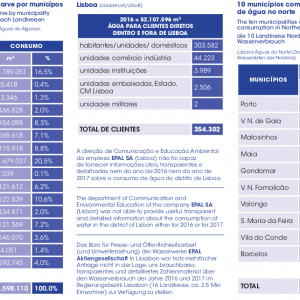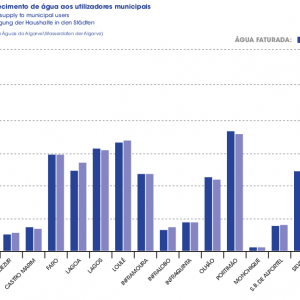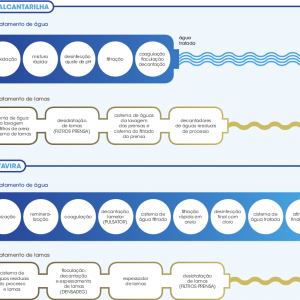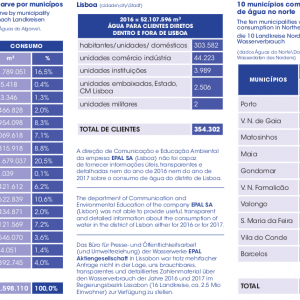
Teresa Fernandes, head of Communication and Environmental Education at Águas do Algarve, the company that is responsible for the region’s water supply, admits that there is a possibility of a water shortage in the medium to long term. However, even if it doesn’t rain, she guarantees that there will be no lack of water for the local population, at least before the end of this year.
Is water becoming a kind of “blue gold”?
In my view, water is more important than gold, absolutely anywhere in the world, because it is irreplaceable. We can’t live without water, which is fundamental for the survival of all human beings. If I don’t have any oil, then I can use gas, solar or wind power, but water is irreplaceable. We’re now beginning to talk more and more about the value of water, because of climate change, and because we’re in the midst of a period of drought. Unfortunately, people have short memories, and when there is an abundance of water they tend to forget how valuable it is. At Águas do Algarve, we are investing heavily in environmental education, mainly among children and young people, in order to remind them of the value that water has. We consider this initiative to be a very positive one, because schoolchildren can learn this message more easily, and we have this same feedback from their parents.
Water is a raw material that costs nothing to produce, comes from a natural source and is then sold at a good price. Isn’t this a good business?
The price of water isn’t set by Águas do Algarve. Instead, it’s approved by a regulatory authority, and, furthermore, water doesn’t have a zero cost. We have an investment of 400 million euros that is spent just on supplying water, and another one of almost 600 million spent on water and sanitation. Water has a very high financial cost, with its infrastructures costing a great deal of money to be built. Our company has already existed for 18 years, so you should also think about the costs of maintenance and reagents, and the staff costs, too. There are all kinds of associated costs, which most people have no idea about. Whenever you turn on the tap, whether it’s to wash the floor or your car, the water you use has had the same treatment as the water for everyday consumption. The costs are extremely high. Energy is another area where we’re making a huge investment, producing alternative energies so that we can treat the water at zero cost in terms of energy consumption. We have two large photovoltaic parks, at the Tavira and Alcantarilha water treatment plants, which are providing the energy for the plants themselves, and we’re continuing to invest in this area, with the purchase of electric vehicles. We already have 15 of these in the Algarve.
How is the water supplied and what is the volume of its consumption?
The average water consumption in the Algarve amounts to 70,000,000 m3 per year. We have managed to guarantee that there will be enough water in the taps, in terms of both quantity and quality, to supply the population in the Algarve until the end of the year, even if it doesn’t rain. The water we supply comes from two types of sources. There’s the surface water obtained from the reservoirs of Odelouca, Odeleite and Beliche, and we also have groundwater catchments, with four boreholes that supply some quite sizeable volumes. The Bravura lake serves as an intermediary reservoir: the water from Odelouca passes through there. It arrives at Bravura and then we channel the to the water treatment plant at Alcantarilha. The water of the Arade and Funcho reservoirs is used for agricultural purposes. We know that the drought is coming and we’re not ignoring it. It’s the result of all the climate changes we’ve been undergoing and we call upon people to be intelligent in the way they consume water.
What changes were made after the drought that affected the region roughly 13 years ago?
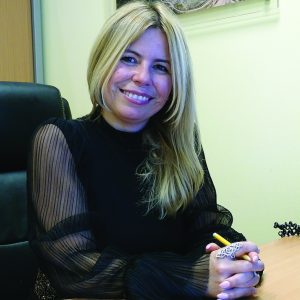 We didn’t have a very resilient system, and it was due to this serious crisis that we have since developed several measures. One of these was to build the reversible pumping station in Loulé. When necessary, we can pump water from the east to the west of the Algarve, or vice-versa. We have also built the Odelouca dam and reservoir, which didn’t exist before and which provides a good cushion for the population in terms of water reserves.
We didn’t have a very resilient system, and it was due to this serious crisis that we have since developed several measures. One of these was to build the reversible pumping station in Loulé. When necessary, we can pump water from the east to the west of the Algarve, or vice-versa. We have also built the Odelouca dam and reservoir, which didn’t exist before and which provides a good cushion for the population in terms of water reserves.
Roughly 100 million euros were invested in the Odelouca dam and reservoir, and it currently has just a third of the amount of water that it recorded at this time last year. What went wrong?
It all has to do with climate change. The figure is based on how much it rained: in the previous water year, there were some heavy rains and we managed to collect a large amount. Last year, it almost didn’t rain at all and there was no water collected. The volume of water has been decreasing, unlike the reservoirs in the east of the Algarve, where fortunately it has rained a lot. If there’s no rainfall, we don’t have any other way of collecting water in Odelouca. This was a fundamental investment, and it’s a very important reserve for our region. Without it, it would be very complicated to continue supplying water to the local population and we would be back to where we were in 2004 and 2005 when we were using a raft to practically scrape the water off the mud at the bottom of the Odeleite and Beliche reservoirs. Thanks to the Odelouca reservoir, this situation no longer exists. We supply the region with 70 million m3 of water per year, and at this moment we have a total volume of 50 million m3, plus the groundwater supplies. There will be enough water to meet the region’s needs, just with the Odelouca reservoir and the groundwater reserves.
Must we prepare for water rationing in the future?
In the near future, I don’t think so, because we have water and it has been raining. There may possibly be some wastage and some situations that we could perhaps exploit to our better advantage. We know that there is a drought happening, right now, but the water continues to flow from our taps. There are only a few people who are truly aware of the situation, even though we have constantly been informing people about what is going on and warning them to ration their use of water. Nonetheless, people still continue to use water excessively, they don’t control the amounts they use when showering or having a bath, or think about the times when they do this, or how much water they use when doing the washing-up with the tap running. Besides the domestic consumption of water, there’s also the question of agriculture, industry and livestock production, all of which consume far more water. Whereas domestic consumption accounts for around 20% of water use, this other type of consumption amounts to between roughly 60% and 70%, so that there also needs to be a better strategy for water use in this latter area. .
What measures are being taken to deal with this situation?
This part is up to the Ministry of Agriculture or the Ministry of the Environment. Our task has to do with maintaining the public water supply to the population. As far as the public supply is concerned, we are making every effort to reduce losses in the supply networks. Fortunately, our multi-municipal system for the supply of water is a new system, built from scratch. Since 1995, we have so far invested 400 million euros, just in the water supply system alone and our losses are around 1%, which is a very low figure. This figure has nothing to do with the numbers recorded by the municipal networks, even though we are aware of the great efforts being made by the municipalities themselves to reduce this percentage. There are some losses that cannot be attributed just to leaks in the network. These have to do with the places where there aren’t any meters installed: schools or other situations where water is supplied and not charged for, or gardens being watered at what are probably inappropriate times, road watering and other situations.
What products are used in the treatment of water? Fluoride or chlorine?
If we’re talking about disinfecting water, one of the components used is chlorine, but this treatment is a very complex process, both before and after disinfection. We have four large water treatment plants, in Beliche, which only comes into operation at the peak of the summer season due to the increased population. The rest of the year, this system is switched off and the same thing applies to the Fontaínhas Water Treatment Plant in Portimão. Then we have the plants at Tavira and Alcantarilha, which are the two largest and are in operation all year round.
Alcantarilha serves the whole of the western region and Tavira serves the whole of the eastern Algarve. The production capacity at Alcantarilha is 259 thousand m3 per day, while Tavira, which is a little smaller, has a production capacity of 190 thousand m3 per day.
In Barcelona, 20% of the public water supply consists of desalinated water. Is there any similar project currently being implemented in Portugal or the Algarve?
No, there isn’t. Desalination is a question that we have discussed and which is still on the table, because of our extensive coastline. However, for the time being, we haven’t moved any further forward in relation to this type of situation, because it is more polluting and consumes more energy. But, with this question of the drought, besides building the Odelouca dam and reservoir, which was fundamental, we have taken care to renew our groundwater catchments. All together, there are four boreholes with quite sizeable volumes, and we’re trying to protect these, so that they will be used only in cases of necessity. Because, if an excessive amount of water is extracted, we also have the problem of saline intrusion, which damages the aquifers. We’re taking great care to protect our groundwater networks.
In the Algarve, there were 18 million overnight stays in 2017, just up to the month of November alone. With a population of over 1.5 million people in the summer, are there any emergency plans in place for combating a water shortage at the peak of the summer season?
This isn’t easy, but we know how to manage water, so that all the structures of Águas do Algarve have been designed to meet the consumption requirements, taking into consideration the greatest peaks that exist during the year. The Algarve is a region that is different from the rest of the country, and our company is different from the other companies belonging to the Águas de Portugal group, precisely because of this seasonal aspect. But we have emergency and contingency plans in place for any time of the year, and not just for the summer. If there’s going to be a water shortage, then we’ll know about it in advance. Our map is updated on a weekly basis and we already know the variations that take place throughout the year, due to our experience and the evolution that has taken place in previous years.
Portimão is a city with a population of 50 thousand inhabitants, which swells to almost 500 thousand people in the summer. And it doesn’t yet have a wastewater treatment plant. Why?
The drains feed into the old infrastructure and the waste goes to the lagoons where it is treated, because there was no other way of solving this question. But we’re making every effort to change this and we’ll be opening a wastewater treatment plant in Portimão at the beginning of March. The waste will be treated using the very latest technology, and the smells we currently face will be considerably reduced. The clean water will then be fed into the River Arade, to be used for watering green spaces or for other purposes in the municipality of Portimão, such as washing the streets, or for cleaning refuse collection equipment or dustcarts, because the water has already been treated and is of the highest quality.
Thank you.
 Eco123 Revista da Economia e Ecologia
Eco123 Revista da Economia e Ecologia

